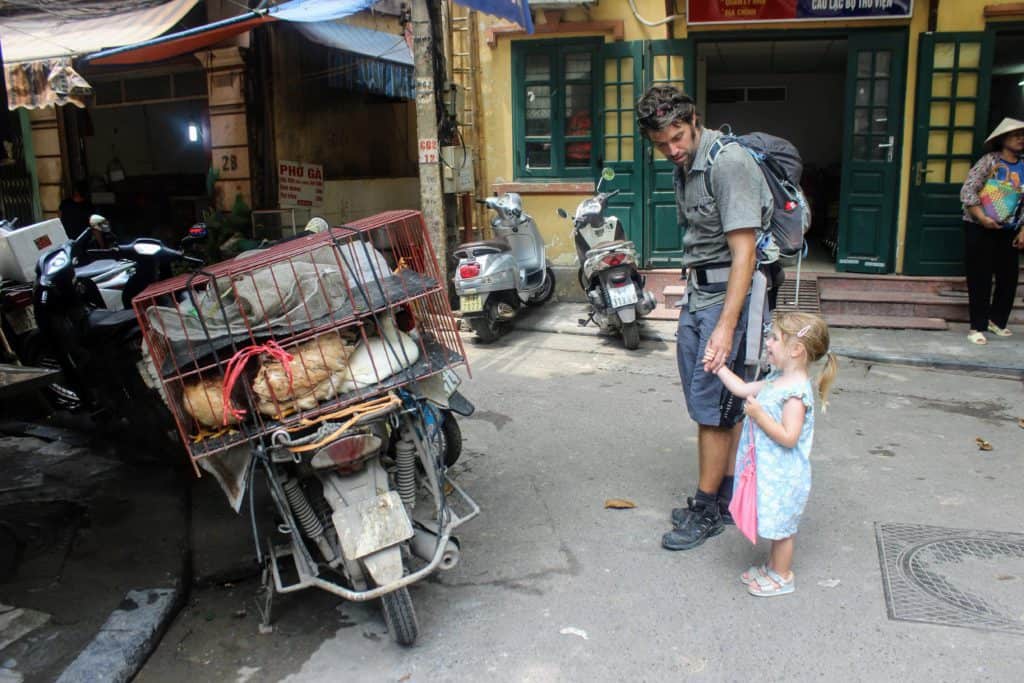In this guide to family travel in Vietnam we will pass on our top tips for travel in Vietnam with a baby, Vietnam with a toddler and Vietnam with kids that are a bit older.
When our second daughter was approaching her first birthday, we used our Shared Parental Leave (a combination of maternity/paternity leave that is now available to parents in the UK) to spend a few months travelling in South East Asia.
We arrived in Vietnam at the end of this 3 month trip to South East Asia and were there to celebrate our daughter’s first birthday.
Our Guide to Vietnam with Kids
Before we left, we couldn’t find very much information online about taking young kids to Vietnam, so we have produced this guide to help you to decide whether going to Vietnam with kids is right for your family.
Before deciding on actual destinations and what we would do with our time in Vietnam, we wanted to be sure that it would actually be a safe and enjoyable place to spend time as a family.
What We Wanted to Know Before We Went to Vietnam
Is Vietnam Safe for Kids?
Top of our list of concerns was the health of our children. Going to new places where the healthcare is unknown, diseases are different and you don’t speak the language can be a little bit daunting.
We are not healthcare professionals and the information on this page is based upon our own research and experience.
If you are going to Vietnam (or anywhere else), we recommend that you visit your doctor 2 months before you leave to ensure you have up to date information and have all the necessary immunisations.
Typhoid and Hepatitis A and B can be an issue especially in rural areas so it is worth getting jabs for these. There are others like rabies and Japanese Encephalitis that you may wish to consider depending on your travel plans.
Please discuss this with your doctor and visit this page for some great general health advice.
Not all vaccinations can be given to babies and young children so be sure to check with your doctor what is available to you and your family.
How Good Is Healthcare In Vietnam?
Vietnam has quite good healthcare facilities but you do need to consider where you are going and the distance to healthcare facilities as some remote areas have virtually no healthcare services.
In general the quality of healthcare is not quite up to the standards of Thailand or Malaysia and you absolutely need to ensure that you have adequate medical cover in your travel insurance.
Some wealthy Vietnamese or expats living in Vietnam choose to go to Bangkok or Singapore for specialist or emergency treatment.
Having good travel insurance will at least enable you to do whatever is necessary should you have any unwanted incidents.
For insurance cover, check out World Nomads which offers great cover for low prices. We like them for a few reasons:
- They are backed by specialist insurers and global assistance partners
- You can Buy Online, even if you’ve already left home
- You can buy more cover and claim online while travelling
- The cover includes a range of adventure sports and activities
- They give a little back and support a community development project
In Vietnam you will find public hospitals and private hospitals, both will require payment for treatment and should be covered by your insurance policy. The public hospitals are often underfunded and lacking in equipment and staff are likely to only speak Vietnamese.
Private hospitals are generally excellent and may have internationally trained staff that are more likely to speak English.
Check out these Related Posts
What are the Biggest Health Concerns in Vietnam?
If you take some sensible precautions in Vietnam you should not experience any major health risks during your visit.
Drinking-Water
You should avoid drinking tap water in Vietnam and buy bottled water instead.
In most restaurants, ice is made using boiled or bottled water and is generally safe to drink. If the ice is the round, machine-made type you should be fine to drink it.
Sun and Heat
The biggest day to day risk is from the sun and heat that you are likely to experience in Vietnam. Sunburn, sunstroke and dehydration are a real risk in Vietnam. It can get very hot and you and your kids should always wear sunscreen with high UV protection all the time.
If you are travelling with a baby or toddler you need to be particularly careful of the sun and heat.
Vietnam can be hot depending on where and when you visit, so you will want to factor that into the types of activities that you do and the places that you visit.
The coast can prove refreshing with a nice breeze, whilst highland areas light Dalat and Sapa will give you the chance to escape the worst of the heat. We always made sure that our accommodation had air con so that we had a cool place for our baby to nap and for us to escape the heat of it all became a bit too much.
It is best to try and avoid doing anything too strenuous during the heat of the day, be sure to keep yourself hydrated and retreat into the shade or air-con if you need.
Tropical Disease in Vietnam
One of our first concerns when choosing a destination was to avoid the risk of catching malaria. You can check the malaria map for Vietnam here.
These maps are updated fairly frequently but are not an absolute guarantee. As you can see from the map there are some areas in Vietnam where there is a high risk of malaria, but in general, the coastal areas are ok and we stuck to these parts of the country.
Dengue fever was our biggest concern before and during our trip. It is a serious disease and can be caught all over Vietnam. There is no vaccine and prevention relies upon the avoidance of being bitten.
To reduce the chance of being bitten we took mosquito repellent that was suitable for young children, a travel cot that was fully enclosed in mosquito mesh, and 2 further mosquito nets for ourselves and our toddler.
As it is spread by mosquitos that are active during the day it is hard to completely eliminate the risk of being bitten.
Food in Vietnam
Vietnamese food is famous throughout the world and you can be sure to get some wonderful fresh food during your visit. Restaurants and street vendors provide tasty eats and low prices so you will be able to try all sorts of delicious things.
If you or your kids aren’t too keen on Vietnamese food you should be able to find international cuisine in most tourist destinations.
If you have a baby, a chair harness like the one we took will come in handy as it was not that common to find high chairs in restaurants.
Vietnamese People
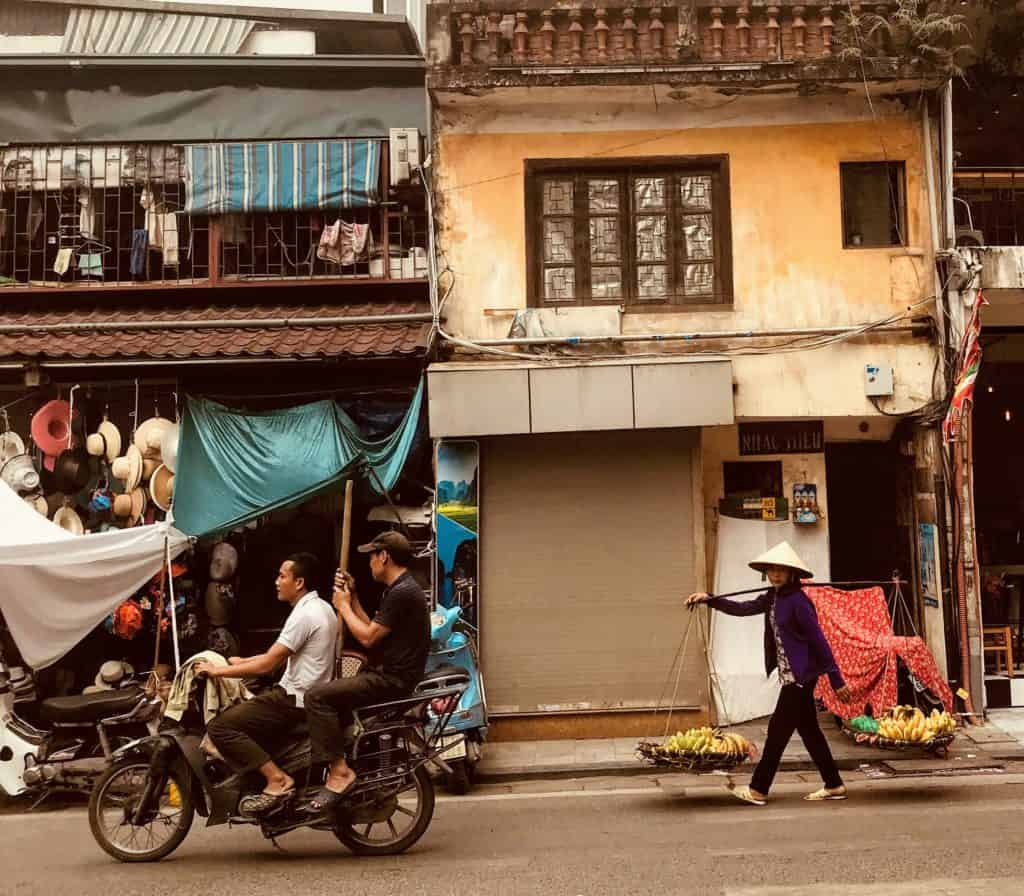
The Vietnamese people we came across were all very friendly. They absolutely love babies so if you are travelling to Vietnam with a baby you can expect to attract lots of attention and have plenty of opportunities to interact with the locals.
It is worth being prepared for the fact that the locals will stroke your baby’s skin or hair and they may want to hold your child.
In our experience, this felt friendly and natural and we didn’t have a problem with it but it is something to be aware of and it is a good idea to think about how you will react in these situations.
There were a couple of times when groups of camera-wielding Chinese tourists wanting to take a picture of the girls became a bit too much, and I felt the need to take them away from the situation.
We are ok with people taking photos if the girls don’t mind. Unfortunately, we have found that they will generally carry on taking pictures even if the girls turn away and we ask them to stop. In that situation, I try to walk away with them.
I did appreciate the irony of a fully robed Buddhist monk wanting to photograph our children since he was exactly the kind of person I would have tried to photograph on previous trips!
Vietnam with a Baby or Toddler
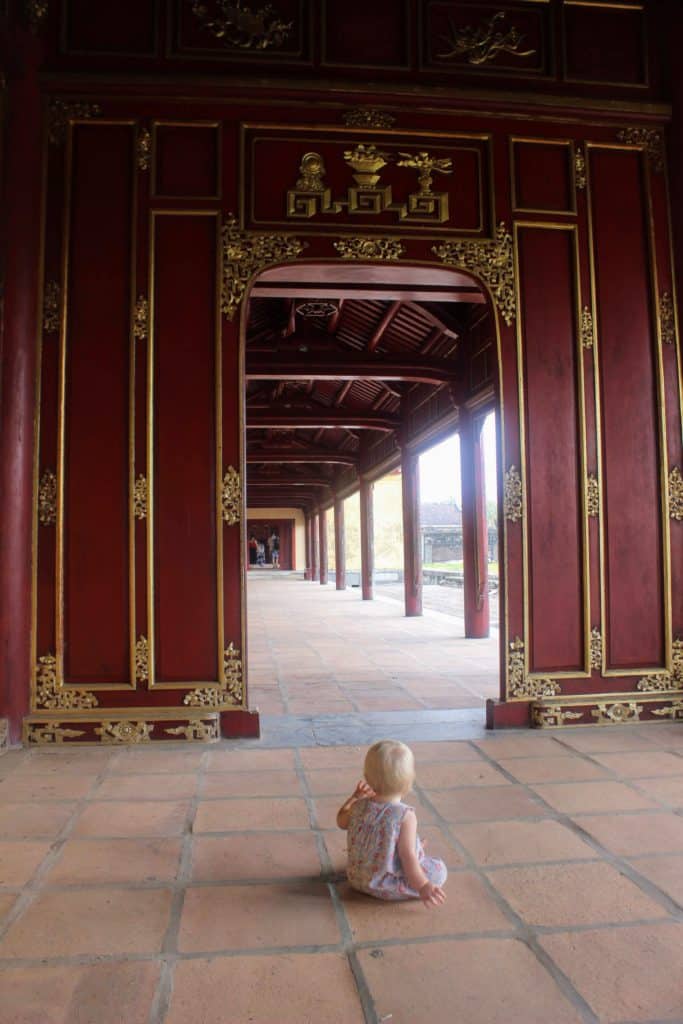
This section is our guide to taking a baby to Vietnam. We will try to cover all the things that you might be wondering about before you travel to Vietnam with a baby or toddler.
You should also check out our packing list and tips for helping a baby to sleep well when travelling.
What is it like travelling around Vietnam with a Baby and Toddler?
We really enjoyed our time travelling around Vietnam with young kids. The country is filled with so much colour and vibrancy that it provides a wonderful travel experience. In a short time, we saw some amazing landscapes, incredible temples, and charming towns, and we met some wonderful people.
Our baby celebrated her first birthday there having had the chance to see and learn so much that would have been different to staying at home. All experiences shape your children as they develop and we feel that our 3 year old really enjoyed the new experiences and developed into a worldly-wise young traveller.
It wasn’t always easy though. Our youngest was just at that age where she would put everything in her mouth and was an enthusiastic crawler but not yet walking.
This was quite challenging as there the floors are generally pretty grubby when you are out and about and babies will inevitably put things in their mouths that you would prefer that they didn’t.
There is little getting around that fact that your little one will crawl around some pretty dirty places and end up looking like she has been wearing the same clothes for months even if you just changed her an hour or two before.
You won’t find formal baby changing facilities so a changing matt like the one we use is essential so that you can at least make a clean space for nappy changes. You will need to find a place that suits you whether that be a bench, temple floor, a quiet spot in a restaurant or wherever you can find.
It is important to be realistic about what you can achieve and how much you want to travel. Consider taking taxis for medium-distance journeys, they are great value and offer comfort and flexibility on your trip and make it so much easier to get around with young kids.
Can You Buy What You Need for a Baby?
You can find most of what you need in Vietnam. We always like to leave home prepared so we take a decent supply of nappies, wipes and food with us.
We also take a first aid kit that covers all the basics. Basic medical supplies are easily available in pharmacies that you will find all over the place, but it is best to have them in advance so you have them when they are needed.
Are Nappies or Diapers available in Vietnam?
Finding nappies/diapers and wet wipes is easy as they are stocked in convenience stores like Circle K, Shop & Go and Vinmart should have what you need. Mamy-Poko is the most expensive and best brand of nappies, they are a Japanese brand and are a similar quality to the Pampers we get in the UK.
If you are heading to remote locations or smaller towns it is well worth stocking up with nappies before you leave the city.
We always travel with a decent supply of nappies from home so that we are under pressure to hunt some down in the first few days of our trip.
Feeding Babies in Vietnam
Babies are generally not breastfed in public in Vietnam so it is best to be discreet about this, possibly using a scarf or muslin for added privacy. Formula milk and pre-packaged milk are available if required. Finding facilities to sterilise your bottles may not always be easy.
Finding Baby Food in Vietnam
We recommend that you bring a decent supply of packaged baby food with you. It is super convenient to have a few pouches of healthy food or some healthy snack bars in your bag for when your baby or toddler get hungry.
This means that you won’t get caught out needing to look for somewhere to eat when you are in the middle of exploring a temple or climbing a mountain.
In Vietnam, ready-made baby foods are not generally used by the local people who tend to feed their babies with rice porridge, vegetables or meat. This means that pre-prepared baby foods are quite hard to find in Vietnam.
They also tend to have different ideas of what babies should eat and some of the products that are available and aimed at babies are really sugary and possibly not what your child is used to.
You can find baby foods in some large supermarkets around Hanoi and Ho Chi Minh City. Or you can find imported baby food at L’s Place and Annam Gourmet in Hanoi and HCMC.
Vietnam with Kids Practicalities
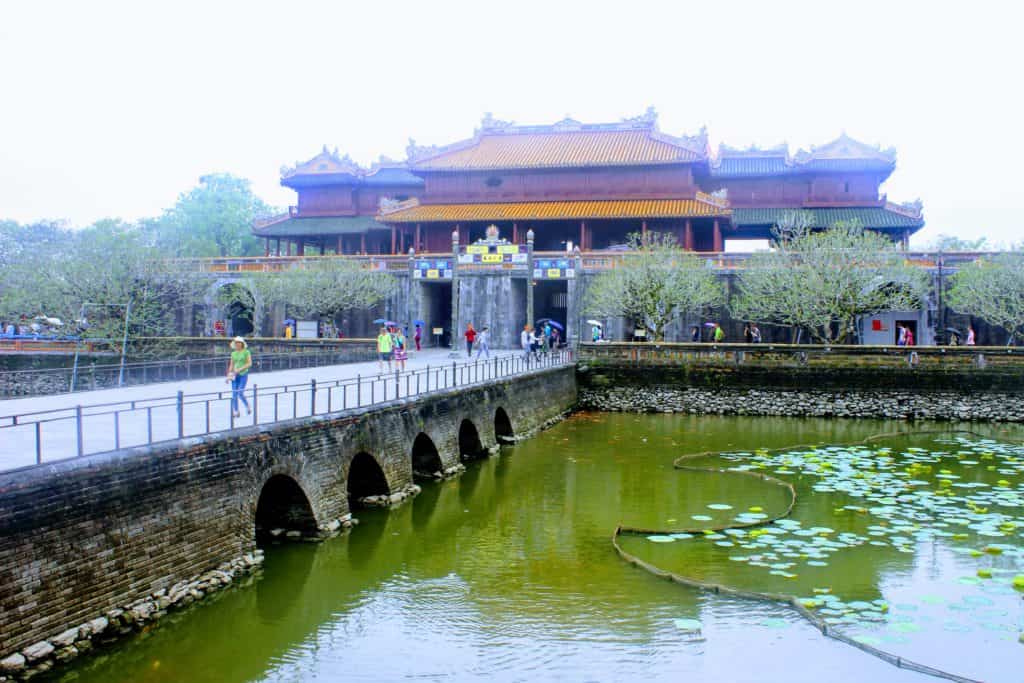
When to Go to Vietnam
Weather in Vietnam
Vietnam generally a warm and humid country, but as it is a big and long country, the weather across the country can vary quite significantly between regions.
There is not really a right and wrong time to visit Vietnam but you will want to plan your family trip to Vietnam taking account of both when and where you would like to go.
Up in Hanoi and the north you have clear winter and summer seasons with a cool, dry winter that lasts from November to April and see temperatures average 17-22°C. The mountains of the far north get very cold around December and January. From May to October, it is hot and humid in the north with high rainfall (July-September are usually the wettest).
In the south, temperatures are pretty much the same all year round (ranging between 25-35C) so the big change is the rain.
The rainy season runs usually from around May until November. Generally, this will consist of short sharp showers and you should still be able to do most of what you want to do and will have plenty of time not getting drenched.
The Dalat highlands are cooler than other areas and this makes them a great place to spend a few days escaping the heat.
Central Vietnam is hot and dry from mid-January to late August, with temperatures often reaching the mid-30’s °C. During the winter months, there is more rainfall with October and November the wettest months.
Hue is often cooler than Hoi An, and as they are on opposite sides of a small mountain range the weather can differ between the two places even on the same day.
For more detailed climate and weather information please click here
Festivals in Vietnam
Another factor that may influence the timing of your visit if you want to plan your visit around one of Vietnam’s festivals. Most festivals are based on the Chinese Lunar calendar, and dates will move slightly each year but it is easy to find out when they will be.
The Tet festival around Chinese New Year is probably the biggest festival whilst the monthly lantern festival in Hoi An is fairly easy to fit into your plans and attracts huge crowds.
Booking Flights to Vietnam
Vietnam has 3 main international airports in Hanoi (Noi Bai International Airport), Da Nang and Ho Chi Minh City (Tan Son Nhat International Airport).
Due to the linear nature of the country, you might want to fly into Hanoi and work your way down to Ho Chi Minh for your flight home (or the other way round). Using Da Nang gives you the option of covering less ground.
You can check for the best prices using Skyscanner. If it works out better to have a return flight from the same airport there are plenty of internal flights that you can use to save retracing your steps on the ground.
You can also use the 7 other national airports and to get around between the places you want to see. We flew from Hue to Hanoi rather than taking the train and it was very easy and cheap to do.
Vietnam Visa Requirements
The visa situation in Vietnam is really complicated and changes all the time so we suggest you head over here to check the latest.
Currently, some nationalities are able to visit Vietnam without a visa, but only for a short length of time. UK passport holders get 15 days visa-free as do citizens of several other European countries. Australians, Americans and Canadians will need to get a visa under current rules. This can change so check the latest situation here.
For longer stays, or if you are from a country that is not visa-exempt, you can get a tourist visa for 30 or 90 days.
There are three ways to get your visa: Visa on Arrival (VOA), e-Visa, or from an embassy.
Visa on Arrival isn’t as easy as it sounds. You need to arrange this in advance by filling in a form with an online agency, their service costs around $20. They send you a letter to print out and when you arrive in Vietnam you hand over your letter get stamped in (for a fee of $25 for single entry, $50 for multiple entry). There are loads of online agencies to apply with, www.vietnamvisachoice.com has a good reputation.
The e-Visa isn’t as easy as it sounds. This is a new way to get a visa that is only open to some nationalities. The system isn’t great and the website is prone to glitches.
They can be really fussy about the photos submitted and be careful to avoid typos as you could get deported for spelling mistakes. Here is the site you need to apply for an e-Visa, hopefully, it will improve.
Getting a visa from an embassy is as hard as it sounds. The fees are higher than using a visa agency and processing times can be slow.
All in all, there is no perfect way to get your visa but the VOA is likely to be your best option.
What to Pack for Vietnam with Kids
For our trip to Vietnam with children, we used a 100 litre wheeled duffle bag, along with two Osprey backpacks.
Using these backs meant that we were able to transport all of our luggage plus the girls in their baby/toddler carriers (these are absolutely essential if you have younger children) when we need to travel about between hotels and various different forms of transport.
For a complete packing list check out this post where we go into detail on what we recommend packing for south-east Asia.
If you are in a hurry our top 5 things to take are:
- Kids Water Bottle and Plastic food tubs (these ones are good)
- Pop up travel cot (check out our travel crib reviews)
- Totseat chair harness
- UV protective swimsuits
- Travel changing mat (we took this one and it was great)
Getting Around Vietnam with Kids
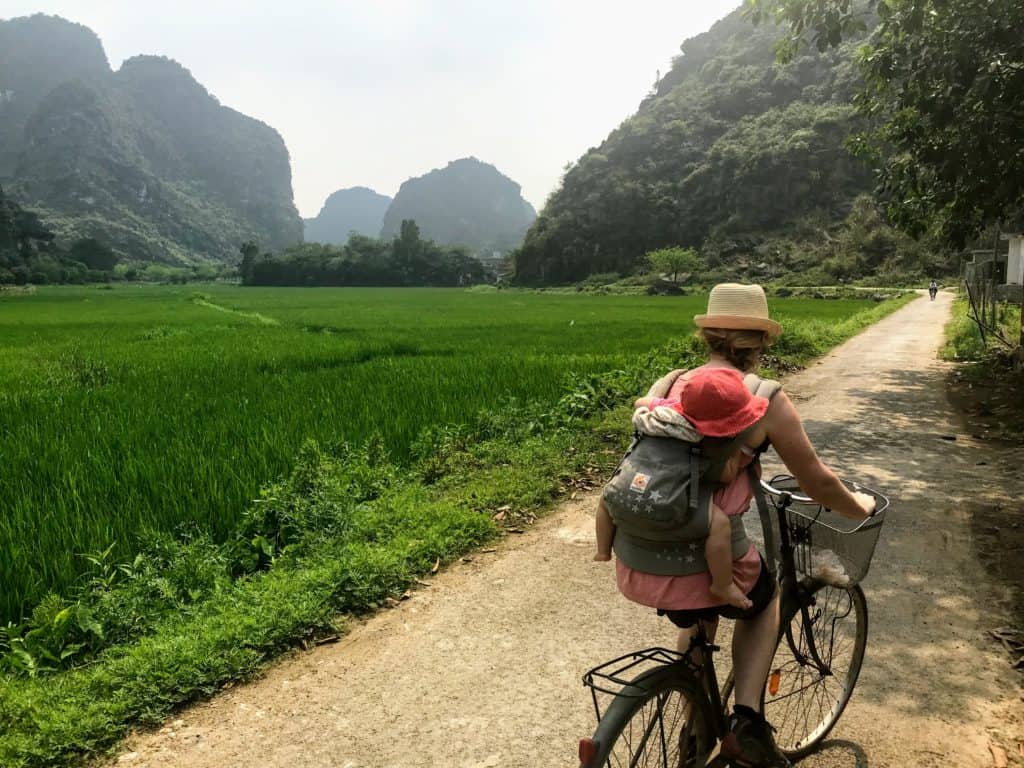
Getting around Vietnamese cities by foot can be a challenge with kids. In cities like Hanoi, HCMC, and Hue you won’t find any reliable pavements to get you to where you are going.
You might find the occasional stretch of decent pavement but then it’ll become blocked by motorbikes or chairs or something and you will be forced out into the road. In other places, you won’t have any pavements at all.
If you are travelling with a baby or toddler we recommend taking a baby carrier rather than a stroller.
In most places a stroller would become more of a hassle than a benefit so we recommend leaving it at home. A baby carrier is pretty much an essential, even for toddlers that can walk.
It means that you can keep them safe from the traffic and gives you the chance to explore further and faster than if they were walking all the time.
We have this one that is designed with a mesh to help keep your little one cool so it is ideal for travelling in tropical countries, read more about it here.
Crossing the road is much like in any Asian country and requires you to boldly cross in front of the traffic and work your way over between the oncoming cars and motorbikes (there are loads of bikes in Vietnam). If it is not something you are used to, find a local crossing the road and copy what they are doing!
Long-distance travel in Vietnam with Kids
Vietnam is a big country and distances between the main sights can be quite long. For this reason, you may want to consider taking some internal flights to cut down on the journey times with kids in tow.
Train
The reunification express runs all the way from Hanoi to Ho Chi Minh City and often forms the backbone of Vietnam itineraries. We always prefer trains to buses as they are more spacious and allow you and your kids to get up and move about.
The train is pretty slow so you might want to take sleeper trains where possible.
You can also reach Sapa by train, or head up to the Chinese border by train if your adventures take you in that direction.
Bus
There is a pretty comprehensive network of buses that connect most cities in Vietnam. Many of these have fairly home-made looking sleeper beds built in for longer journeys.
Private Car or taxi
We found that private cars and taxis were a great way to get around for journeys of an hour or two. They were amazingly good value, could take you door to door, and offered the chance to stop off at points of interest along the way.
We particularly recommend doing this for the journey between Hoi An and Hue which involved a couple of changes by bus/train and was only fractionally cheaper than the taxi that took us all the way there with stops at the Marble Mountains and Hai Van.
Taxis don’t provide car seats but we generally found that they had seat belts in place. We held our baby in our ergo carrier for car journeys. If you are on a shorter trip and expect to travel around by car, you might want to consider bringing your car seat from home.
If you have children over 4 we recommend this portable travel booster seat which is easy to carry around and works great for taxi journeys. You can read our review here.
Final Thoughts on Travelling to Vietnam with Kids
We hope that you have enjoyed reading our best tips for family travel in Vietnam. It is a wonderful country and you are sure to have a wonderful time in Vietnam with your children. It is an exotic, adventurous and exciting destination to take your family and it will provide some fantastic family memories.
We have some other posts that will help you to plan your trip. Have a look at our guides to Hoi An and Hanoi. We always like to have a good guidebook with us when we travel.
If you have enjoyed reading this post or have any queries that we haven’t covered, please comment below.

